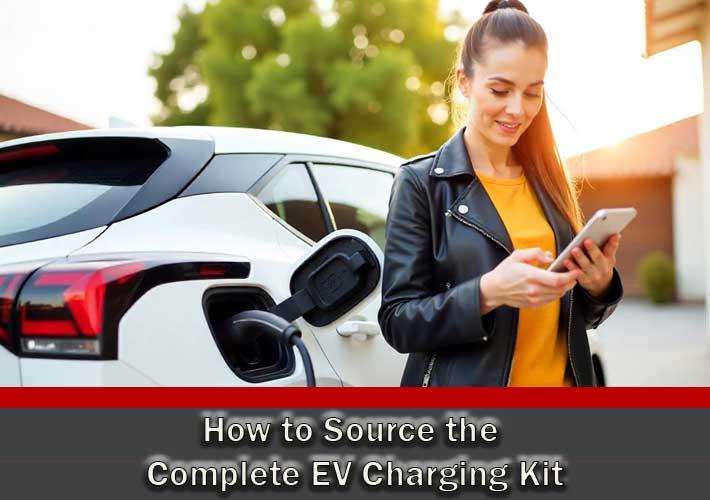 Add My Company
Add My Company
How to Source the Complete EV Charging Kit

Planning to install an EV charger at home or for a client? Make sure you don’t miss any crucial components. Whether you’re a homeowner setting up your first electric vehicle charger, a qualified electrician preparing a quote, or an installer needing a comprehensive reference, this guide covers everything from earthing rods to smart chargers.
Electric vehicle charging isn’t just about choosing a charger – it’s about ensuring the entire installation is safe, compliant with UK regulations, and future-proof. That includes selecting the right earthing method, RCD protection, cable sizing, and a smart charge point that meets the UK Smart Charge Point Regulations.
We’ll take you step by step through the process, with trusted product recommendations along the way – from FuseBox consumer units and Doncaster EV-Ultra cable to smart chargers like the Aurora Seren and Rolec EVO. Whether you’re doing professional sourcing or researching for a DIY install, you’ll find everything you need here.
Step 1: Earthing – Grounding the EV Charger Safely
Proper earthing is essential, especially in homes with a PME (TN-C-S) supply. UK Wiring Regulations (BS 7671) require that outdoor EV chargers are not directly earthed via the PME system. Instead, a separate TT earthing system is often used – this involves installing an earth rod to provide a safer earth reference in case of a PEN (Protective Earth and Neutral) fault.
Recommended Earthing Kit:
-
Unicrimp 5/8" Earth Rod (1200 mm) – A copper-bonded rod offering low resistance.
-
Unicrimp Rod-to-Cable Clamp – Ensures a strong connection to the earth cable.
-
Unicrimp Earthing Inspection Box – A ground-level pit for inspecting and testing the connection.
Though smaller rods (e.g. 3/8") are available, the marginal cost difference makes the 5/8" option more sensible for long-term reliability.
Aim for an earth resistance below 200Ω – many EV chargers require less than 150Ω to operate correctly. An earth tester should be used to confirm compliance.
Note: Some EV chargers have built-in PEN fault detection, which may eliminate the need for a separate earth rod, but this should always be confirmed in the charger’s specifications.
Step 2: Circuit Protection – RCDs and Consumer Units
EV chargers draw high, continuous current (typically 32 A) and must be installed on a dedicated circuit with suitable protection.
RCD Type Matters:
-
Type A RCDs detect AC and pulsating DC leakage. Suitable when the charger includes internal 6mA DC protection (RDC-DD).
-
Type B RCDs detect all forms of fault current, including smooth DC. Required if the charger lacks DC detection. However, these are significantly more expensive.
Recommended:
-
Use a Type A 30mA RCD if the charger has RDC-DD.
-
Opt for an all-in-one Type A RCBO (RCD + MCB) where possible for simplicity and cost savings.
FuseBox Options:
-
IP65-rated EV consumer units for outdoor or garage installs.
-
IP20-rated indoor boards for internal installations.
Look for units that include:
-
32A Type A RCBO
-
100A main switch
-
Surge protection (SPD) where needed
A dedicated consumer unit avoids nuisance tripping and simplifies future maintenance.
Note: All work should be carried out or certified by a registered electrician. EV charger installation is notifiable under Part P of UK Building Regulations.
Step 3: Cable Selection – Sizing and Routing
The cable must safely carry 32 A continuously. Here’s what to consider:
-
6mm² SWA cable is suitable for most domestic installs up to ~20–30 metres.
-
10mm² cable is better for longer runs (40–50 metres or more) or where derating factors apply (e.g. insulation, buried cable).
EV-Ultra Cable by Doncaster Cables is highly recommended:
-
Combines power and data (Cat5e) in one sheath
-
Ideal for chargers needing a CT clamp or smart integration
-
Available with steel wire armour for extra protection outdoors
Fixings: Use LINIAN fire-rated clips to support cables in compliance with wiring regulations (plastic clips alone are not acceptable).
For buried cables:
-
Lay at ~450mm depth in domestic gardens
-
Use warning tape above the cable
-
Consider ducts for future maintenance
Ensure proper gland termination, especially if using SWA, and earth the armour correctly.
Step 4: Selecting and Installing the EV Charger
Now that the infrastructure is ready, you can install the charger itself.
Top Recommended Units:
1. Aurora Seren 7.4kW Smart Charger
-
Type 2 socket
-
Built-in 30mA Type A RCD, 6mA DC detection and PEN fault protection
-
Wi-Fi/app control
-
IP55 and IK10 rated
-
Key lock and colour customisation
-
3-year warranty
2. Rolec EVO 7.4kW Intelligent Charger
-
Type 2 socket
-
Integrated PEN fault protection (no earth rod required)
-
Internal 30mA RCD and 6mA DC detection
-
Dynamic load balancing
-
App scheduling and solar integration
-
5-year warranty
Both units are OZEV-approved, UK-compliant, and built for outdoor use.
Other Notable Options:
-
Zappi by MyEnergi – Best for solar homes
-
Pod Point – A widely installed, reliable option
Installation Tips:
-
Mount at ~1.2 metres high on an external wall
-
Use the manufacturer’s template for drilling
-
Terminate live, neutral and earth cables per the manual
-
Install any CT clamp for load balancing if required
-
Test the unit, including RCD and PEN fault features
-
Label the consumer unit appropriately
Conclusion: Your Complete EV Charging Kit at Home
To install an EV charger correctly, safely, and to regulation standards, you’ll need to cover all key components:
1. Earthing: Protect against supply faults with a dedicated earth rod or built-in PEN protection.
2. Protection: Use a Type A 30mA RCD or RCBO, ideally inside a dedicated consumer unit like FuseBox’s IP65 EV kits.
3. Cabling: Choose suitable cable – often 6mm² or 10mm² SWA – and consider EV-Ultra for data and power in one.
4. Charger: Pick a smart, safe, and regulation-compliant charger like Aurora Seren, Rolec EVO, Zappi, or Pod Point.
Every item plays a role in creating a reliable and efficient home EV charging setup. Use trusted brands, check compatibility, and always follow current UK Wiring Regulations. With the right kit, you’ll be charging your vehicle safely and smartly for years to come.
For more information on How to Source the Complete EV Charging Kit talk to Expert Electrical Supplies Ltd

